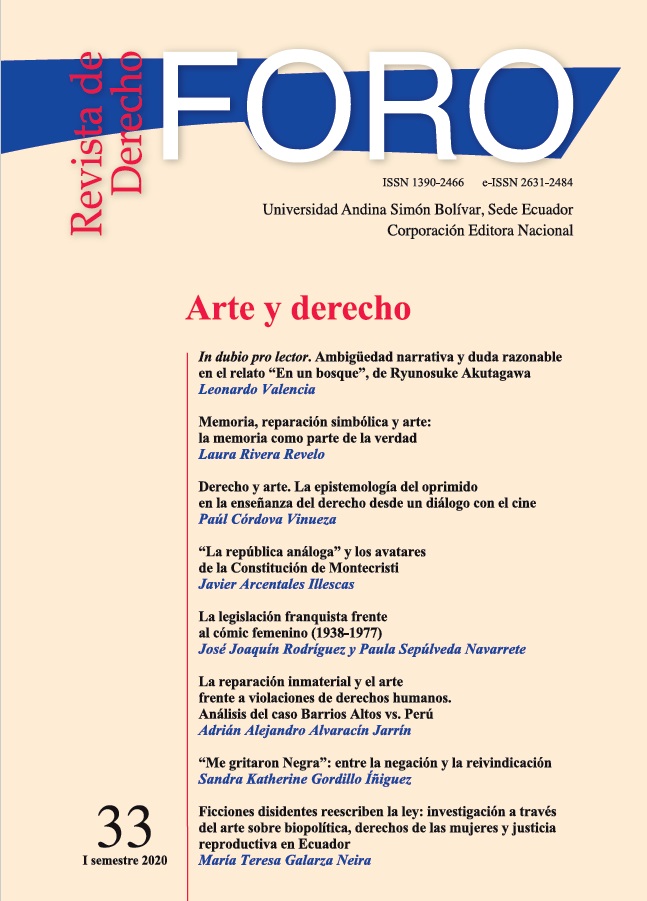La reparación inmaterial y el arte frente a violaciones de derechos humanos. Análisis del caso Barrios Altos vs. Perú
Contenido principal del artículo
Resumen
La tarea investigativa emprendida en este trabajo evalúa mediante estándares doctrinales la reparación inmaterial dictada por la Corte Interamericana de Derechos Humanos en la sentencia emblemática del caso Barrios Altos vs. Perú, a fin de analizar en la ratio decidendi si la actuación de la Corte Interamericana de Derechos Humanos se ajusta a una visión integral sobre reparación simbólica. El presente trabajo se justifica en la manera en que las víctimas aparecen como actores secundarios en la realización de las obras de arte como objeto de reparación inmaterial, ante lo cual se busca la forma de que las mismas sean sujetos protagonistas, considerando relevante su intervención al momento de establecer la forma y fondo de las manifestaciones artísticas como objeto de su reparación. Como metodología se aplica el estudio de caso, mismo que permite a través del análisis de la sentencia expuesta, formular propuestas amplias y generales en cuanto a la reparación simbólica. Como resultado, se interconecta el arte con el derecho y se propone una reparación inmaterial respetuosa de las vivencias, experiencias y reclamos de las víctimas de violaciones a los derechos humanos. En las conclusiones se señala las falencias de la Corte Interamericana de Derechos Humanos al momento de aplicar estándares doctrinales que permitan una reparación inmaterial basada en una dialéctica entre decisión judicial, víctimas, artistas y el Estado, con el propósito de fomentar conciencia y encaminar una reparación transformadora de la realidad.
##plugins.themes.bootstrap3.displayStats.downloads##
Detalles del artículo
Sección
CESIÓN DE DERECHOS, DECLARACIÓN DE CONFLICTO DE INTERESES Y DIFUSIÓN
Los autores/as que publiquen en esta revista aceptan las siguientes condiciones:
- Los autores ceden a la Foro: Revista de Derecho, el derecho de la primera publicación. Las obras se publican en la edición electrónica e impresa de la revista bajo una Licencia Creative Commons 4.0 de Reconocimiento No Comercial-Compartir Igual 4.0, que habilita a compartir, adaptar y atribuir el trabajo (ver: Políticas de acceso abierto).
- Ver información completa de cesión de derechos, declaración de conflicto de intereses y difusión, aquí
Cómo citar
Referencias
Ávila Santamaría, Ramiro. La utopía del oprimido. Los derechos de la pachamama (naturaleza) y el sumak kawsay (buen vivir) en el pensamiento crítico, el derecho y la literatura. Ciudad de México: Akal, 2019.
Barthes, Ronald. Mitologías. Buenos Aires: Siglo XXI, 2008. Benjamin, Walter. “La obra de arte en la época de su reproductibilidad técnica”. 1989. ‹https://www.ucm.es/data/cont/docs/241-2015-06-06-Textos%20Pardo_Benjamin_La%20 obra%20de%20arte.pdf›.
––. La obra de arte en su reproductibilidad técnica. Ciudad de México: Ítaca, 2003.
Corte Interamericana de Derechos Humanos. “Resolución de supervisión de cumplimiento”. Caso Barrios Altos y Caso la Cantuta vs. Perú. 30 de mayo de 2018.
––. “Sentencia de fondo, reparaciones y costas”. Caso del Penal Miguel Castro Castro vs. Perú. 25 de noviembre de 2006.
––. “Sentencia de fondo, reparaciones y costas”. Caso La Cantuta vs. Perú. 29 de noviembre de 2006.
––. “Sentencia de fondo”. Caso Barrios Altos vs. Perú. 14 de marzo de 2001.
––. “Sentencia de reparaciones y costas”. Caso Barrios Altos vs. Perú. 30 de noviembre de 2001.
––. “Resolución de supervisión de cumplimiento”. Caso Barrios Altos vs. Perú. 7 de septiembre de 2012.
Guglielmucci, Ana. “El concepto de víctima en el campo de los derechos humanos: una reflexión crítica a partir de su aplicación en Argentina y Colombia”. Revista de Estudios Sociales, n.º 59 (2017): 83-97. ‹http://www.redalyc.org/pdf/815/81549422008.pdf›.
Heidegger, Martin. Caminos de bosque. Madrid: Alianza Editorial, 1995.
López Medina, Diego Eduardo. El derecho de los jueces. Bogotá: Legis Editores, 2008.
Parra Cortés, Lina Victoria. “Relaciones entre el arte y el derecho: ejemplos del arte en los procesos de protesta, memoria y reparación”. Anamorphosis-Revista Internacional de Direito e Literatura 5, n.o 1 (2019): 235-52. ‹http://seer.rdl.org.br/index.php/anamps/article/view/468/pdf›.
Sierra León, Yolanda. “Relaciones entre el arte y los derechos humanos”. Revista Derecho del Estado, n.o 32 (2014): 77-100. ‹https://revistas.uexternado.edu.co/index.php/derest/article/view/3815›.
Vargas Llosa, Mario. “El ojo que llora”. El País, 2019. ‹https://elpais.com/diario/2007/01/14/opinion/1168729205_850215.html›.
Villabella, Carlos Manuel. “Los métodos en la investigación jurídica. Algunas precisiones”. En Metodologías: enseñanza e investigación jurídicas, editado por Wendy Aide Godínez Méndez y José Heriberto García Peña, 921-53. Ciudad de México: UNAM / Tecnológico de Monterrey, 2015. ‹https://archivos.juridicas.unam.mx/www/bjv/libros/8/3983/46.pdf›.
Zaffaroni, Eugenio Raúl. Crímenes de masa. Buenos Aires: Ediciones Madres de Plaza de Mayo, 2012.
––. “El discurso feminista y el poder punitivo”. En Las trampas del poder punitivo. El género del derecho penal, editado por Haydée Birgin, 19-30. Buenos Aires: Biblios, 2000. ‹http://www.biblio.dpp.cl/biblio/DataFiles/14202.pdf›.


